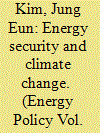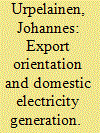|
|
|
Sort Order |
|
|
|
Items / Page
|
|
|
|
|
|
|
| Srl | Item |
| 1 |
ID:
096159


|
|
|
|
|
| Publication |
2010.
|
| Summary/Abstract |
Contend that contrary to traditional notions of a weak national state in our nation's early years, the national state, acting through the Army, was indispensable in shaping the pattern and direction of economic development. They propose a new way of conceptualizing the early American state: a state of the periphery, dominated by the Army, and a state of the center, in which other public institutions also performed key development functions.
|
|
|
|
|
|
|
|
|
|
|
|
|
|
|
|
| 2 |
ID:
170848


|
|
|
| 3 |
ID:
127996


|
|
|
|
|
| Publication |
2014.
|
| Summary/Abstract |
Fast growing global energy needs raise concerns on energy supply security and climate change. Although policies addressing the two issues sometimes benefit one at the expense of the other, technology innovation, especially in alternative energy, provides a win-win solution to tackle both issues. This paper examines the effect of oil endowment on the patterns of technology innovation in the transportation sector, attempting to identify drivers of technology innovation in alternative energy. The analysis employs panel data constructed from patent data on five different types of automobile-related technologies from 1990 to 2002: oil extraction, petroleum refining, fuel cells, electric and hybrid vehicles (EHV) and vehicle energy efficiency. I find that countries with larger oil endowments perform less innovation on refining and alternative technologies. Conversely, higher gasoline prices positively impact the patent counts of alternative technologies and energy efficiency technology. The findings highlight the challenges and importance of policy designs in international climate change agreements.
|
|
|
|
|
|
|
|
|
|
|
|
|
|
|
|
| 4 |
ID:
109453


|
|
|
|
|
| Publication |
2011.
|
| Summary/Abstract |
Why are some countries developing many energy efficiency innovations, while others are lagging behind? I argue that export orientation and electricity at low variable cost from nuclear and hydropower plants have an interactive effect on energy efficiency innovation. Export-oriented countries have strong incentives to invest in energy efficiency innovation, as they are in a position to export these technology innovations for global markets. But if inexpensive electricity is supplied in a country, the domestic demand for energy efficiency innovation is missing, and so the home market cannot serve as a springboard for international commercialization. I test this theory against international patent data on energy efficiency innovation in insulation, heating, and lighting for 22 OECD countries, 1991-2007. The statistical analysis indicates that export orientation has large positive effects on energy efficiency innovation in countries that do not rely on nuclear and hydroelectricity.
|
|
|
|
|
|
|
|
|
|
|
|
|
|
|
|
| 5 |
ID:
125429


|
|
|
|
|
| Publication |
2013.
|
| Summary/Abstract |
Given the ever-increasing pace and complexity of technological innovation in the energy sector, monitoring technological changes has become of strategic importance. One of the most common techniques for technology monitoring is patent analysis, which enables the identification of technological trends over time. However, few previous studies have carried out patent analysis in the energy sector. This study aims to explore patterns of innovation and of evolution in energy technologies, particularly focusing on similarities and differences across technologies. For this purpose, we first defined the relevant energy technologies and extracted the associated patent data from the United States Patents and Trademark Office (USPTO) and then adopted six patent indices and developed six patent maps to analyze their innovation characteristics. We then clustered energy technologies with similar characteristics, so defining innovation categories, and analyzed the changes in these characteristics over time to define their evolution categories. As one of the few attempts to investigate the overall trends in the energy sector's innovation and evolution, this study is expected to help develop an in-depth understanding of the energy industry, which will be useful in establishing technology strategies and policy in this rapidly changing sector.
|
|
|
|
|
|
|
|
|
|
|
|
|
|
|
|
| 6 |
ID:
031057


|
|
|
|
|
| Publication |
Oxford, Pergamon Press, 1967.
|
| Description |
xix, 248p.
|
|
|
|
|
|
|
|
|
|
|
|
Copies: C:1/I:0,R:0,Q:0
Circulation
| Accession# | Call# | Current Location | Status | Policy | Location |
| 003770 | 338.064/SCH 003770 | Main | On Shelf | General | |
|
|
|
|
| 7 |
ID:
096114


|
|
|
|
|
| Publication |
2010.
|
| Summary/Abstract |
Fuel cells have gained considerable interest as a means to efficiently convert the energy stored in gases like hydrogen and methane into electricity. Further developing fuel cells in order to reach cost, safety and reliability levels at which their widespread use becomes feasible is an essential prerequisite for the potential establishment of a 'hydrogen economy'. A major factor currently obviating the extensive use of fuel cells is their relatively high costs. At present we estimate these at about 1100 €(2005)/kW for an 80 kW fuel cell system but notice that specific costs vary markedly with fuel cell system power capacity. We analyze past fuel cell cost reductions for both individual manufacturers and the global market. We determine learning curves, with fairly high uncertainty ranges, for three different types of fuel cell technology - AFC, PAFC and PEMFC - each manufactured by a different producer. For PEMFC technology we also calculate a global learning curve, characterised by a learning rate of 21% with an error margin of 4%. Given their respective uncertainties, this global learning rate value is in agreement with those we find for different manufacturers. In contrast to some other new energy technologies, R&D still plays a major role in today's fuel cell improvement process and hence probably explains a substantial part of our observed cost reductions. The remaining share of these cost reductions derives from learning-by-doing proper. Since learning-by-doing usually involves a learning rate of typically 20%, the residual value for pure learning we find for fuel cells is relatively low. In an ideal scenario for fuel cell technology we estimate a bottom-line for specific (80 kW system) manufacturing costs of 95 €(2005)/kW. Although learning curves observed in the past constitute no guarantee for sustained cost reductions in the future, when we assume global total learning at the pace calculated here as the only cost reduction mechanism, this ultimate cost figure is reached after a large-scale deployment about 10 times doubled with respect to the cumulative installed fuel cell capacity to date.
|
|
|
|
|
|
|
|
|
|
|
|
|
|
|
|
| 8 |
ID:
103457


|
|
|
|
|
| Publication |
2011.
|
| Summary/Abstract |
This research builds a technology-based bottom-up model to estimate the performance of China's coal-fired electricity industry on resource consumption and environmental emissions. From the integrated estimation of three scenarios characterizing different stages of technology innovation in 2007-2030, technology innovation is proven to be the determinant in decreasing resource use and environmental effects from electricity production, but analysis based on current policies reveals some doubt in achieving the coal consumption intensity control target. Constrained with national control targets, the best route of technology innovation is calculated by integrated benefit targeting optimization. Supercritical (SC) and ultra-supercritical (USC) pressure boilers, flue gas desulfurization (FGD) and closed-cycle wet cooling with a high circulation ratio will be the mainstream technologies before 2030 based on current policy. It is inevitable to close or reconstruct small power plants from the late 2010s, and integrated gasification combined cycle (IGCC) and pressurized fluidized bed combustion combined cycle (PFBC-CC) plants will show a competitive advantage in the late 2020s. However, air cooling and FGD systems will expand slower than the authorities' expectation, while higher water prices and SO2 charges promote the expansion. Stricter restrictions are also found to be positive for technological progress.
|
|
|
|
|
|
|
|
|
|
|
|
|
|
|
|
| 9 |
ID:
177166


|
|
|
|
|
| Summary/Abstract |
Wind energy technologies have seen a rapid decline in costs in the last two decades, but the drivers for these cost reductions are poorly understood. This paper addresses this knowledge gap by quantitatively investigating the drivers behind the cost reductions of onshore wind turbines between 2005 and 2017. Starting from a bottom-up cost model, the paper advances the methodology by identifying the techno-economic variables responsible for cost reductions of individual components (in $/kW) and linking them to drivers, specifically: learning by-deployment, learning-by-researching, supply-chain dynamics, and market dynamics. The analysis finds that changes in materials (copper, fiberglass, and iron), labour (employee productivity), legal and financial costs contributed over 30% to the cost reduction of wind turbine prices over the period 2005–2017. Moreover, learning-by-deployment was the most important innovation driver, being responsible for half of the cost reduction. The findings point to the importance of policies tailored to technology's stage of development. For onshore wind energy, which entered a mature phase in the period covered by this analysis, policy support for the needs of a growing industry such as stable support schemes together with appropriate regulatory and investment environments were more important than direct policy support for R&D which played a more important role in earlier periods.
|
|
|
|
|
|
|
|
|
|
|
|
|
|
|
|
|
|
|
|
|